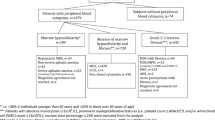Abstract
The aim of the present study was to analyze the nucleolar organizer region (AgNOR) pattern of granulopoietic precursors in chronic myeloid leukemia (CML) at diagnosis and during the course of the disease. Clusters of AgNORs and isolated dots were counted separately in 24 cases of CML at diagnosis, in 19 cases during the relapse of the chronic phase after treatment, and in 16 cases of blast crisis. For comparison, 20 cases of normal bone marrow were studied. Each cell type had its own characteristic AgNOR pattern, as has been described for normal bone marrow. There was no significant difference in the number of AgNORs between cells in the peripheral blood and bone marrow. Compared with normal granulopoiesis, myeloblasts in CML at diagnosis had lower numbers of clusters, which decreased further during relapse of chronic phase and in blast crisis. Promyelocytes and myelocytes showed significantly fewer dots. The number of AgNOR clusters correlates inversely with the duration of the cell cycle. Therefore, these findings are consistent with the progressive loss in proliferative activity of immature precursors described during the course of CML. As the number of dots indicates cellular maturation, their lower number in promyelocytes and myelocytes in CML favors the concept of a discordant maturation process described in this desease. The separate counting of clusters and dots provides a useful, simple, and cheap method of describing cytokinetic changes during the course of this myeloproliferative
Similar content being viewed by others
References
Crocker J (1990) Nucleolar organizer regions. Curr Top Pathol 82:91–149
Derenzini M, Trérè D (1991) Importance of interphase nucleolar organizer regions in human pathology. Virchows Arch [B] 61:1–8
Rüschoff J, Plate KH, Müller R, Maasberg M, Thomas C (1993) Nucleolar organizer region-associated proteins: a diagnostic tool in cytology? Recent Results Cancer Res 133:81–89
Crocker J, Boldy DAR, Egan MJ (1989) How should we count AgNORs? Proposals for a standardized approach. J Pathol 158:185–188
Ferrari AR, Bianchi FM, Migliorini L (1993) Proposta de un metodo de valutazione semiquantitativa delle AgNORs. Pathologica 85:661–665
Grotto HZW, Lorand-Metze I, Metze K (1991) Nucleolar organizer regions in normal hematopoiesis: relationship to cellular proliferation and maturation. Nouv Rev Fr Hematol 33:1–4
Nikicicz EP, Norback DH (1990) Argyrophilic nucleolar organizer region staining in normal bone marrow cells. J Clin Pathol 43:723–727
Trérè D (1993) Critical analysis of the methods commonly employed in the assessment of cell proliferation: advantages of the NOR silver-staining technique in routine cyto-histopathology. Anal Cell Pathol 5:191–201
Ogawa M, Fried J, Sakai Y, Strife A, Clarkson BD (1970) Studies of cellular proliferation in human leukemia. Cancer 25:1031–1049
Strife A, Clarkson BD (1988) Biology of chronic myelogenous leukemia: is discordant maturation the primary defect? Semin Hematol 25:1–19
Fokas AS, Keller JB, Clarkson BD (1991) Mathematical model of granulocytopoiesis and chronic myelogenous leukemia. Cancer Res 51:2084–2091
Smith R, Crocker J (1988) Evaluation of nucleolar organizer region-associated proteins in breast malignancy. Histopathology 12:113–125
Glantz SA (1987) Primer of biostatistics, 2nd, edn. MC Graw Hill Information Services, New York
Wachtler F, Schwarzacher HG, Ellinger A (1982) The influence of the cell cycle on structure and number of nucleoli in cultures human lymphocytes. Cell Tissue Res 225:155–163
Capova A, Baldini A, Marlekaj P, et al (1985) Hormonemodulated rRNA gene activity is visualized by selective staining of the NORs. Cell Biol Int Rep 9:791–796
Metze K, Lorand-Metze I (1991) AgNOR staining in normal bone marrow cells. J Clin Pathol 44:526
Metze K, Lorand-Metze I (1992) Silver staining of nucleolar organizer regions in prostatic lesions. Histopathology 21:97–98
Kropff M, Wenzler Th, Wagner A, Muller CP, Bocking A (1990) Prediction of blast crisis in chronic myelogenous leukemia by DNA single cell cytometry. Verh Dtsch Ges Pathol 74:126–129
Grotto HZW, Metze K, Lorand-Metze I (1993) Pattern of nucleolar organizer regions in human leukemic cells. Anal Cell Pathol 5:203–212
Metze K, Lorand-Metze I (1993) Interpretation of the Ag-NOR pattern in hematologic cytology. Acta Haematol 89:110–111
Author information
Authors and Affiliations
Rights and permissions
About this article
Cite this article
Gilberti, M.F.P., Metze, K. & Lorand-Metze, I. Changes of nucleolar organizer regions in granulopoietic precursors during the course of chronic myeloid leukemia. Ann Hematol 71, 275–279 (1995). https://doi.org/10.1007/BF01697979
Received:
Accepted:
Issue Date:
DOI: https://doi.org/10.1007/BF01697979




